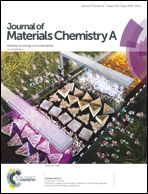Zr-doped ceria additives for enhanced PEM fuel cell durability and radical scavenger stability†
Abstract
Doped ceria compounds demonstrate excellent radical scavenging abilities and are promising additives to improve the chemical durability of polymer electrolyte membrane (PEM) fuel cells. In this work, Ce0.85Zr0.15O2 (CZO) nanoparticles were incorporated into the cathode catalyst layers (CLs) of PEM fuel cells (based on Nafion XL membranes containing 6.0 μg cm−2 ion-exchanged Ce) at loadings of 10 and 55 μg cm−2. When compared to a CZO-free baseline, CZO-containing membrane electrode assemblies (MEAs) demonstrated extended lifetimes during PEM chemical stability accelerated stress tests (ASTs), exhibiting reduced electrochemical gas crossover, open circuit voltage decay, and fluoride emission rates. The MEA with high CZO loading (55 μg cm−2) demonstrated performance losses, which are attributed to Ce poisoning of the PEM and CL ionomer regions, which is supported by X-ray fluorescence (XRF) analysis. In the MEA with the low CZO loading (10 μg cm−2), both the beginning of life (BOL) performance and the performance after 500 hours of ASTs were nearly identical to the BOL performance of the CZO-free baseline MEA. XRF analysis of the MEA with low CZO loading reveals that the BOL PEM Ce concentrations are preserved after 1408 hours of ASTs and that Ce contents in the cathode CL are not significant enough to reduce performance. Therefore, employing a highly effective radical scavenger such as CZO, at a loading of 10 μg cm−2 in the cathode CL, dramatically mitigates degradation effects, which improves MEA chemical durability and minimizes performance losses.



 Please wait while we load your content...
Please wait while we load your content...